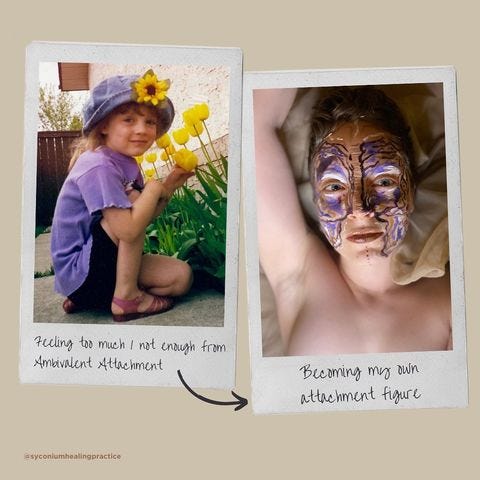What is Relational Object [im]Permanency?
and why do I catastrophize relationships?
I’ve hesitated writing this piece, despite its themes arising in every corner of my life. The hesitation is from the expectation that as a therapist, I should be impermeable to trauma complexes, that I should have it all together. I should have this figured out by now. After 15 years of intentional healing work, intensive study (and I mean intensive), I am still visited by certain complexes. Being a therapist doesn’t make me immune to triggers - and what I always tell clients is that being visited by complexes & triggers doesn’t detract from their healing progress. It is simply a reminder of yours and my human-ness. So this is a reminder to myself and to you, we are still human - we are still in process.
To honour that process, here is a FREE mediation for you to be tender with yourself: https://www.syconium.ca/shop/introspective-meditation
Sometimes if there’s too long of a stretch of silence between us, I ask if they’re mad at me, if they still love me. My ambivalent attachment shows itself in the distrust of love (if you’re curious about your attachment style, take a peek through this quiz: https://forms.gle/yiLsZYeHgxnTmyxLA }, interpreting ambiguous cues as rejection. In the absence of overt acceptance, obvious love, my attachment wounding primes me to be bracing for the inevitable loss of love. In this bracing, my trauma responses are activated and I’m no longer in the present moment but am holding my breath for the inevitable impact.
The priming to expect rejection, abandonment, betrayal and every other attachment wounding is a reflection of relational object impermanency that arises from early trauma, particularly emotional distance. Remember that what children experience is coded in their brain as normal and safe BECAUSE it is familiar, not because it is necessarily normal or safe. And since we are always re-creating our childhood environment, when we experience early rejection, we are unconsciously re-creating that same complex only because it is familiar.
we can really see this re-creation in our draw towards nostalgia - there is a sense of safety we derived from childhood shows
In our healing journey, we can create nuance for our Selves that just because we experienced something as normal, doesn’t mean it is.
Object permanency is a cognitive, emotional understanding that items and people still exist, even when you cannot hear or see them. This is usually developed around 8 months old but continues to develop with nuance as we are informed by our environment and relationships. We can see object IMpermenancy playing hide and seek with children who cover their eyes and really truly believe you cannot see them if they cannot see you - it is as if you don’t exist if they cannot see you. The development of object permanency is impacted by neurodivergency - for example, a common adage with ADHD is “out of sight, out of mind” which is noting an object permanence blockage.
if you’ve ever left spinach in the crisper to rot, that’s related to object impermanency
In a relational sense, object permeance is the belief that the people who say they will be there for you, will be - the belief that love still exists even without overt markers. As in, if your partner isn’t in this moment saying the words, “I love you”, you can still trust that the love exists. Relational object impermanency then is the experience that in the absence of directly overt cues of acceptance, it is as if the love disappears. If your partner is sitting next to you and quietly scrolling on their phone, you may experience that neutrality as rejection.
an example of this is parents who suffer from postpartum depression. This is no fault of the parent but the impact on the child still exists because the child can feel the distance of the parent. We can hold context with compassion. In this case, the child feels the distance between them and their parent and interprets the distance as punishment, something bad that they did. And this is how people pleasing becomes a coping strategy to “get” love - even pre-verbally.
Interpreting benign or neutral cues as unspoken rejection are a priming of attachment woundings where the unspoken was unsafe. This leads to bracing for the inevitable. The purpose of bracing is getting ahead of pain - and also, this coping strategy ends up prolonging our suffering. But people don’t do things for no reason. Bracing for inevitable rejection gives us the opportunity to pre-grieve; the idea that if we pull away first then rejection isn’t as painful because we were never close to begin with. And also, it keeps us from being present with what is.
There is also an expectation of “forever” in relationships and coupled with an all-or-nothing mentality, lead to relational nihilism. Relationships aren’t supposed to last forever - we are gifted with guides throughout the seasons of our lives to accompany us on the journey of self-acceptance and our relationships serve a purpose. Remember that just because something ends, doesn’t mean it wasn’t meaningful - it just means it ends.
Unlearning relational object impermanency requires making conscious this very unconscious complex. It means finding safe places to express our vulnerability. To say, “it feels like you’re far away”, “are you mad at me?”. The trick with making the unconscious conscious is we also have to believe the answer. Otherwise, we are just psychological edging - not allowing the complex to complete itself but simply spinning our tires in place.
To complete the cycle of relational object permanency, keeping evidence of love can be helpful. A note on your phone, a jar of anti-shame messages.
You can learn to trust in love.





